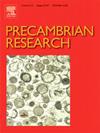Tectonic evolution of the crustal section of the Neoproterozoic Jabal Ess ophiolite-arc complex, Midyan terrane, NW Arabian Shield
IF 3.2
2区 地球科学
Q2 GEOSCIENCES, MULTIDISCIPLINARY
引用次数: 0
Abstract
The Jabal Ess ophiolite arc complex (JEOA) comprises basalt and basaltic andesite lavas and dykes and rare gabbros that range from MORB- and Izu Bonin Marianas forearc basalt (IBM FAB)-like to volcanic arc basalt-like but also comprise high-Mg andesite (HMA) and low-Si boninite (LSB); post-ophiolite formation granitoids intrude the ophiolite complex. Though the mafic rocks have major oxide compositional characteristics similar to MORB and IBM FAB, these mafic rocks exhibit prominent primitive mantle normalized negative Nb/Nb* anomalies and HFSE concentrations that range to much lower than MORB. We posit that the Jabal Ess ophiolite formed in adherence to the subduction initiation rule (i.e., MORB-like lavas followed by HMA and LSB) which is at least partially verified by the fact that LSB diabase are intrusive into lowermost peridotite. U-Pb SHRIMP ages of a lone rhyolite and two granites that intrude ophiolite mafic rocks are 687.6 ± 6.5 Ma and 699.0 ± 6.3 to 702.9 ± 6.2 Ma, respectively, and represent post-collisional granitoids that formed during collision of the Hijaz and Midyan terranes which aided in stitching of the 701–695 Ma Yanbu suture zone.

西北阿拉伯地盾米底地新元古代Jabal - Ess蛇绿岩-弧杂岩地壳剖面构造演化
Jabal - Ess蛇绿岩弧杂岩(JEOA)由玄武岩和玄武岩安山岩熔岩、岩脉和稀有辉长岩组成,从MORB-和Izu Bonin Marianas弧前玄武岩(IBM FAB)到火山弧玄武岩,但也包括高镁安山岩(HMA)和低硅博长岩(LSB);蛇绿岩形成后花岗岩侵入蛇绿岩杂岩。虽然基性岩的主要氧化物组成特征与MORB和IBM FAB相似,但这些基性岩表现出明显的原始地幔归一化负Nb/Nb*异常和远低于MORB的HFSE浓度。我们认为Jabal Ess蛇绿岩的形成遵循俯冲起始规则(即MORB-like lava,然后是HMA和LSB), LSB辉绿岩侵入最下部橄榄岩的事实至少部分证实了这一点。单独的流纹岩和侵入蛇绿岩基性岩的2块花岗岩的U-Pb SHRIMP年龄分别为687.6±6.5 Ma和699.0±6.3 ~ 702.9±6.2 Ma,代表了Hijaz和Midyan地体碰撞形成的碰撞后花岗岩,该碰撞有助于701-695马岩步缝合带的拼接。
本文章由计算机程序翻译,如有差异,请以英文原文为准。
求助全文
约1分钟内获得全文
求助全文
来源期刊

Precambrian Research
地学-地球科学综合
CiteScore
7.20
自引率
28.90%
发文量
325
审稿时长
12 months
期刊介绍:
Precambrian Research publishes studies on all aspects of the early stages of the composition, structure and evolution of the Earth and its planetary neighbours. With a focus on process-oriented and comparative studies, it covers, but is not restricted to, subjects such as:
(1) Chemical, biological, biochemical and cosmochemical evolution; the origin of life; the evolution of the oceans and atmosphere; the early fossil record; palaeobiology;
(2) Geochronology and isotope and elemental geochemistry;
(3) Precambrian mineral deposits;
(4) Geophysical aspects of the early Earth and Precambrian terrains;
(5) Nature, formation and evolution of the Precambrian lithosphere and mantle including magmatic, depositional, metamorphic and tectonic processes.
In addition, the editors particularly welcome integrated process-oriented studies that involve a combination of the above fields and comparative studies that demonstrate the effect of Precambrian evolution on Phanerozoic earth system processes.
Regional and localised studies of Precambrian phenomena are considered appropriate only when the detail and quality allow illustration of a wider process, or when significant gaps in basic knowledge of a particular area can be filled.
 求助内容:
求助内容: 应助结果提醒方式:
应助结果提醒方式:


